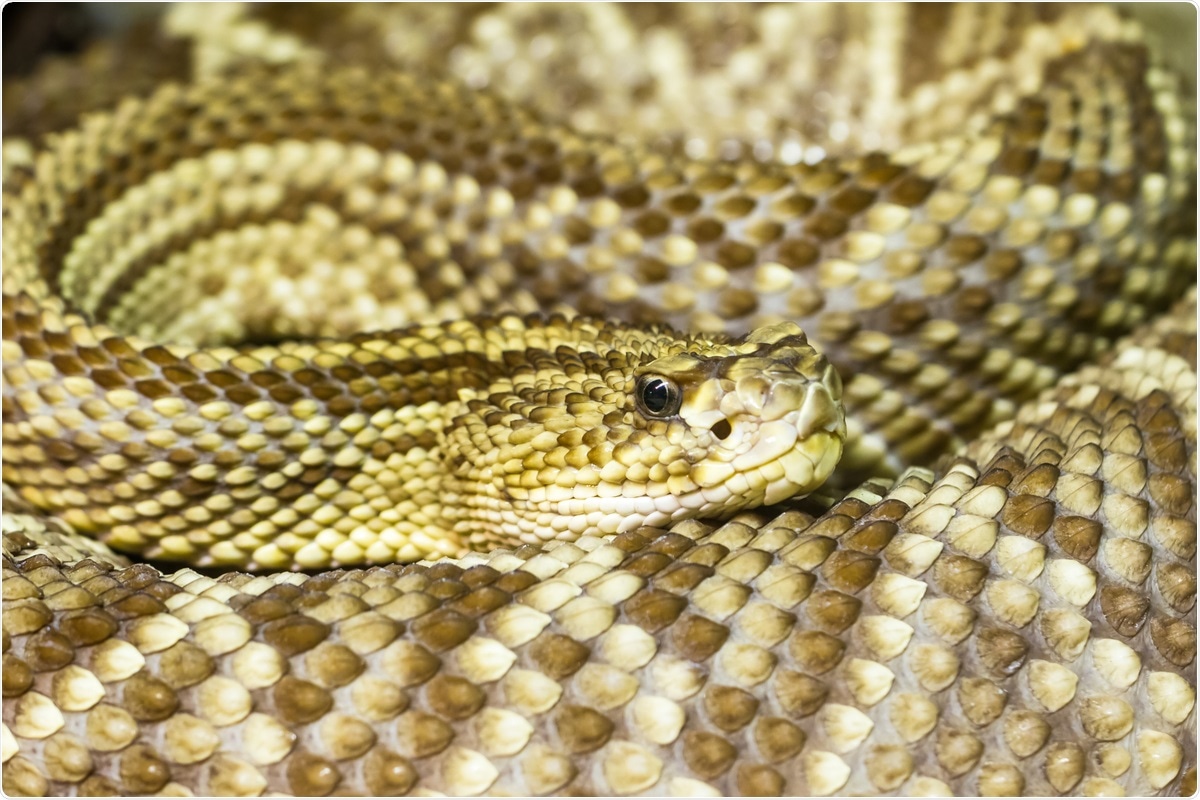New research published in the bioRxiv* preprint server suggests a small cationic peptide known as crotamine may inhibit the replication and transcription of severe acute respiratory syndrome coronavirus 2 (SARS-CoV-2). Crotamine in the D-enantiomer form successfully inhibited SARS-CoV-2 replication by targeting the C30 Endopeptidase (3CLpro protease).
 Study: Design of D-amino acids SARS-CoV-2 Main protease inhibitors using the cationic peptide from rattlesnake venom as a scaffold. Image Credit: Dmitri Gomon/ Shutterstock
Study: Design of D-amino acids SARS-CoV-2 Main protease inhibitors using the cationic peptide from rattlesnake venom as a scaffold. Image Credit: Dmitri Gomon/ Shutterstock

 This news article was a review of a preliminary scientific report that had not undergone peer-review at the time of publication. Since its initial publication, the scientific report has now been peer reviewed and accepted for publication in a Scientific Journal. Links to the preliminary and peer-reviewed reports are available in the Sources section at the bottom of this article. View Sources
This news article was a review of a preliminary scientific report that had not undergone peer-review at the time of publication. Since its initial publication, the scientific report has now been peer reviewed and accepted for publication in a Scientific Journal. Links to the preliminary and peer-reviewed reports are available in the Sources section at the bottom of this article. View Sources
Crotamine is found in rattlesnake Crotalus durissus terrificus venom and has analgesic, antibacterial, and hemolytic properties. Other drugs, such as Enalapril and Eptifibatide, are based on snake venom and approved by the U.S. Food & Drug Administration.
The advantage of the selected wild type was because of their cell penetration properties, even in D-enantiomer form, high stability and specificity, as well as selectivity against the target 3CL protease was observed,” concluded the research team.
Isolating the peptide and administering it at a low dose may help create a coronavirus disease 2019 (COVID-19) treatment for people with severe illness.
The study
The researchers expressed the SARS-CoV-2 3CLpro_GST fusion protein, needed for viral replication, on E.coli Lemo21 cells and later purified them. The viral protease was exposed to both crotamine and modified peptides with substituted cysteine residues known as L-CDP2-9 to determine the best inhibitor peptide.
First inhibition tests showed that L-CDP1, L-CDP2, L-CDP7, and L-CDP8 peptides had an 80% inhibition against the viral protease. They also tested the minimum concentration needed for crotamine to have a 100% inhibition against the 3CLpro protease. A 100% protease inhibition was achieved at 300 µM.
L-CDP1 caused complete inhibition of SARS-CoV-2 protease activity at 30 µM. A crotamine derivative with an amino acid substitution known as L-peptide-7 caused a 100% inhibition at 60 µM.
Substitutions of cysteine residues, specifically a substitution at position 36, increased L-CDP7’s inhibitory activity.
A fluorescence-based protease assay confirmed the peptide’s conformational shape during inhibition. L-CDP1, L-CDP7, and L-CDP8 peptides were found to be competitive inhibitors.
The results indicate that these peptides interact directly with amino acid residues located in the active site or with amino acids located in the substrate-binding region of the protease, preventing substrate entry to the active site,” explained the researchers.
To protect against degradation in L-enantiomer peptides, the research team created CDP1 and CDP7 in D-enantiomer form. The reasoning was that D peptides are more stable; L-CDP peptides can degrade from hydrolysis by proteases. Because the D-peptides were mirror images of L-peptides, the team predicted that binding affinity and their inhibitory effect should be similar. Results showed D-CDP1 and D-CDP7 are also competitive inhibitors. Though, D-CDP1’s interaction with the SARS-CoV-2 protease is ten times stronger than D-CDP7.
Based on the findings, the team next looked at L-CDP1’s and D-CDP1’s molecular docking efficiency using a web simulation. The simulations showed that amino acid residues of the viral protease interacted with ligand binding, suggesting a potential mode of interaction.
The amino acid residue, His41, appeared to interact with the hydrogen bond of L-CDP1’s Lys31 residues. The remaining amino acid residues are in the substrate-binding region, confirming the interaction is competitive inhibition.
D-CDP1, on the other hand, works by placing the peptide in the substrate-binding region, causing the protease’s active site to be blocked.

 This news article was a review of a preliminary scientific report that had not undergone peer-review at the time of publication. Since its initial publication, the scientific report has now been peer reviewed and accepted for publication in a Scientific Journal. Links to the preliminary and peer-reviewed reports are available in the Sources section at the bottom of this article. View Sources
This news article was a review of a preliminary scientific report that had not undergone peer-review at the time of publication. Since its initial publication, the scientific report has now been peer reviewed and accepted for publication in a Scientific Journal. Links to the preliminary and peer-reviewed reports are available in the Sources section at the bottom of this article. View Sources
Journal references:
- Preliminary scientific report.
Eberle RJ, et al. (2021). Design of D-amino acids SARS-CoV-2 Main protease inhibitors using the cationic peptide from rattlesnake venom as a scaffold. bioRxiv, 2021. doi: https://doi.org/10.1101/2021.11.10.468025, https://www.biorxiv.org/content/10.1101/2021.11.10.468025v1
- Peer reviewed and published scientific report.
Eberle, Raphael J., Ian Gering, Markus Tusche, Philipp N. Ostermann, Lisa Müller, Ortwin Adams, Heiner Schaal, et al. 2022. “Design of D-Amino Acids SARS-CoV-2 Main Protease Inhibitors Using the Cationic Peptide from Rattlesnake Venom as a Scaffold.” Pharmaceuticals 15 (5): 540. https://doi.org/10.3390/ph15050540. https://www.mdpi.com/1424-8247/15/5/540.
Article Revisions
- May 8 2023 - The preprint preliminary research paper that this article was based upon was accepted for publication in a peer-reviewed Scientific Journal. This article was edited accordingly to include a link to the final peer-reviewed paper, now shown in the sources section.